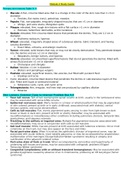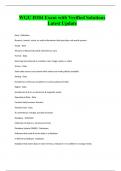Module 2 Study Guide
Primary skin lesions Table 9. 4
Macule: A flat, circumscribed area that is a change in the color of the skin; less than 1 cm in
diameter
o Freckles, flat moles (nevi), petechiae, measles
Papule: Flat, non-palpable, irregularly shaped macules that are >1 cm in diameter
o Vitiligo, port-wine stains, Mongolian spots
Plaque: elevated, firm, rough skin lesions with a flat surface >1 cm in diameter
o Psoriasis, Seborrheic dermatitis, actinic keratosis
Nodule: elevated, firm circumscribed lesions that penetrate the dermis. They are 1-2 cm in
diameter
o Erythema nodosum, lipomas
Wheal: elevated, irregularly shaped areas of cutaneous edema. Solid, transient, and having
varying diameters.
o Insect bites, urticaria, and allergic reactions
Tumor: elevated, solid lesions that may or may not be clearly demarcated. They penetrate deeper
into the dermis and are >2 cm in diameter.
o Neoplasms, benign tumors, and lipomas
Vesicle: elevated, circumscribed superficial lesions that do not penetrate the dermis. Filled with
serous fluid and are <1 cm in diameter
o Chickenpox and shingles
Bullae: Vesicles >1 cm in diameter
o Blisters and pemphigus vulgans
Pustule: elevated, superficial lesions, like vesicles, but filled with purulent fluid
o Impetigo and acne
Cysts: elevated, circumscribed lesions that penetrate the dermis or subcutaneous layers of the
skin. Filled with liquid or semisolid material
o Sebaceous cysts, cysts, and cystic acne
Telangiectasia: fine, irregular, red lines that are produced by capillary dilation
o Rosacea
Skin Lesions: External Clues to Internal Problem Box 9.8
Faun tail nevus: Tuft of hair overlying the spinal column at birth, usually in the lumbosacral area;
may be associated with spina bifida occulta
Epidermal verrucous nevi: Warty lesions in a linear or whorled pattern that may be pigmented
or skin colored; present at birth or in early childhood; associated most with skeletal, central
nervous system, and ocular abnormalities
Café au lait macules: Flat, evenly pigmented spots varying in color from light brown to dark
brown or black in dark skin; present at birth or shortly thereafter; may be associated with
neurofibromatosis or miscellaneous other conditions including pulmonary stenosis, temporal lobe
dysrhythmia, and tuberous sclerosis
Freckling in the axillary or inguinal area: Multiple flat pigmented macules associated with
neurofibromatosis; may occur in conjunction with café au lait macules
Ash leaf macule: White macules present at birth associated with tuberous sclerosis. Occur most
commonly on the trunk, but may also appear on the face and limbs
Facial port-wine stain: When it involves the ophthalmic division of trigeminal nerve, may be
associated with ocular defects, most notably glaucoma; or may be accompanied by angiomatous
malformation of the meninges (Sturge-Kalischer-Weber syndrome) resulting in atrophy and
calcification of the adjacent cerebral cortex
Port-wine stain of limb or trunk: When accompanied by varicosities and hypertrophy of
underlying soft tissues and bones, may be associated with orthopedic problems (Klippel-
Trenaunay-Weber syndrome)
Congenital lymphedema with or without transient hemangiomas: May be associated with
gonadal dysgenesis caused by absence of an X chromosome, producing an XO karyotype (Turner
syndrome)
, Supermumerary nipples: Congenital accessory nipples with or without glandular tissue, located
along the mammary ridge; may be associated with renal abnormalities, especially in the presence
of other minor anomilies, particularly in whites
“Hair collar” sign: A ring of long, dark, coarse hair surrounding a midline scalp nodule in infants
usually an isolated cutaneous anomaly that may indicate neural tube closure defects of the scalp
Abnormalities Skin, Hair Nails Page 162-167
Eczematous Dermatitis: most common inflammatory skin disorder; several forms, including
irritant contact dermatitis, allergic contact dermatitis, and atopic dermatitis
o Itching is commonly present; atopic dermatitis report allergy history (allergic rhinitis,
asthma); for irritant or allergic contact, exposure history is important; erythematous,
pruritic, weeping vesicles
Atopic dermatitis: during childhood, lesions involve flexures, the nape, and the dorsal
aspects of the limbs; in adolescence and adulthood, lichenified plaques affect the
flexures, head, and neck
Folliculitis: inflammation and infection of the hair follicle and surrounding dermis
o Acute onset of papules and pustules associated with pruritis or mild discomfort; may have
pain with deep follicles; Primary lesion is a small pustule 1-2cm that is located over a
pilosebaceous orifice and may be perforated by a hair; the sites most often involved are the
face, scalp, thighs, axilla, and inguinal areas
Furuncle (Boil): a deep-seated infection of the pilosebaceous unit
o Acute onset of tender, red nodule with center filled with pus; Skin is red, hot, and tender;
center of the lesion is purulent and forms a core that may rupture spontaneously or require
surgical incision; sites commonly involved are the face and neck, arms, axillae, breasts,
thighs, and buttocks
Cellulitis: diffuse, acute, infection of the skin and subcutaneous tissue
o Break in the skin, such as a fissure, cut, laceration, insect bite, or puncture wound; pain and
swelling at the site; may have fever; Skin is red, hot, tender, and indurated; borders are not
well demarcated; lymphangitic streaks and regional lymphadenopathy may be present; rare
to have bilateral cellulitis
Tinea (Dermatophytosis): group of noncandidal fungal infections that involve the stratum
corneum, nails, or hair
o May report pruritis, hair breaking, or nail changes accompanying onychomycosis; Lesions
vary in appearance and may be popular, pustular, vesicular, erythematous, or scaling;
secondary bacterial infection may be present; infected nails are yellow ad thick and may
separate from the nail bed
Pityriasis Rosea: self-limiting inflammation of unknown cause
o Sudden onset with occurrence of primary oval (herald) or round plaque; herald lesion is
often missed; eruption occurs 1-3 weeks later and lasts for several weeks; pruritis may be
present
with the generalized eruption; often occurs in young adults during the spring time; Lesions
are usually pale, erythematous, flat-topped papules and plaques with fine scaling; lesions
develop on the extremities and trunk; palms and soles are not involved. trunk lesions are
characteristically distributed in parallel alignment following the skin tension lines in a
Christmas tree-like pattern
Psoriasis: chronic and recurrent disease of keratinocyte proliferation
o May have pruritis; concerns about appearance; does not typically get superinfected;
Characterized by well-circumscribed, dry, silvery, scaling papules and plaques; lesions
commonly occur on the back, buttocks, extensor surfaces of the extremities, and the scalp;
can be associated with psoriatic arthritis in up to 30% of patients; may have pitting nail
involvement
Rosacea: chronic inflammatory skin disorder
o Itching in absent; many pts report a stinging pain associate with flushing episodes; common
triggers are exposure to the sun, cold weather, sudden emotion, hot beverages, spicy foods,
and alcohol consumption; Eruptions appear on the forehead, cheeks, nose, and occasionally
about the eyes; characterized by telangiectasia, erythema, papules, and pustules that occur
particularly in the central area of the face; tissue hypertrophy of the nose (rhinophyma)
may occur, characterized by sebaceous hyperplasia, redness, prominent vascularity, and
swelling of the skin of the nose





